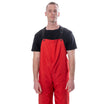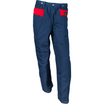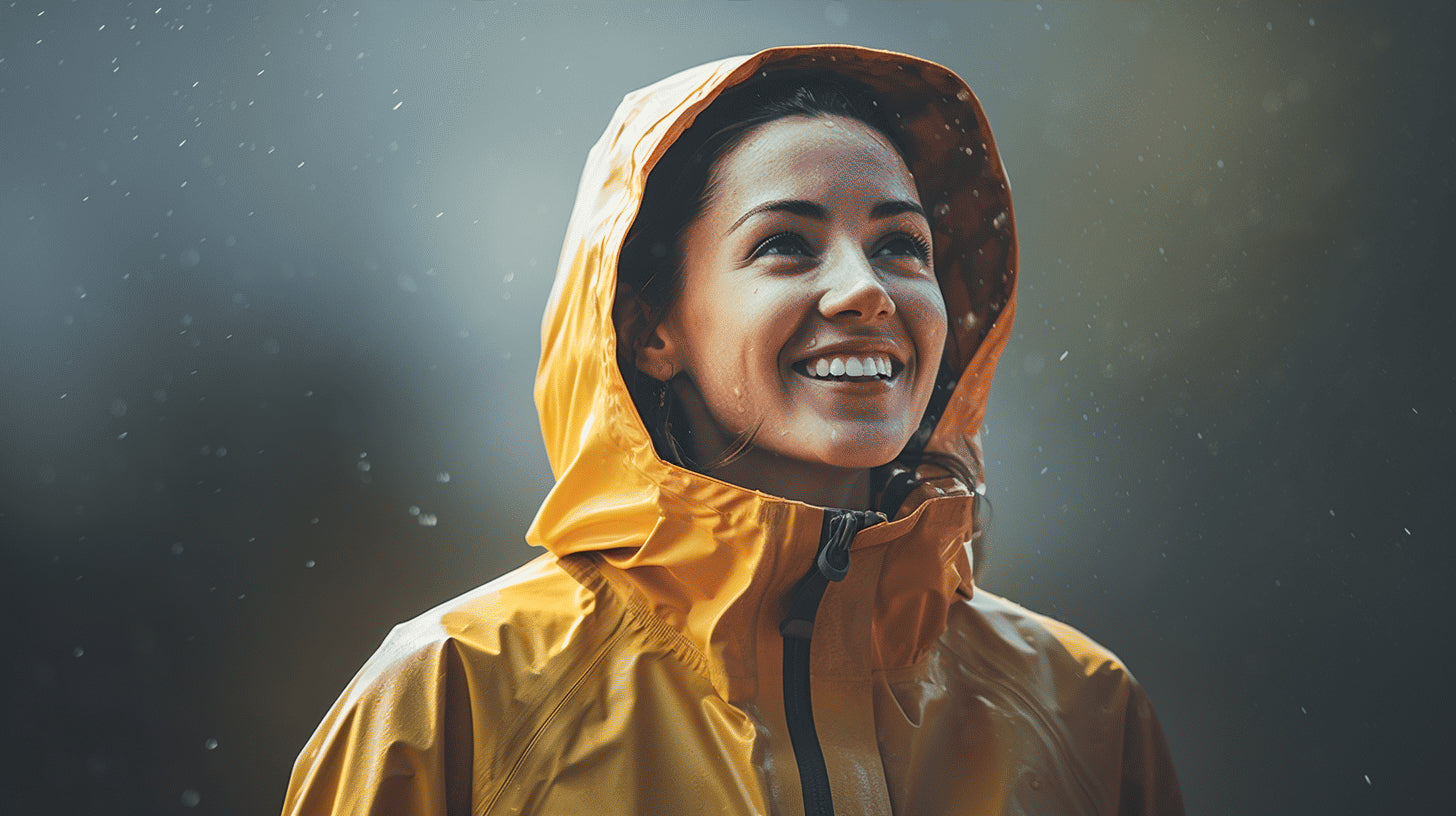Every construction worker knows it's integral to have rain gear that can stand up to the job. When the weather is unpredictable, a stellar set of rain gear could mean the difference between working through a shower and losing a day on the site. In this article, we will delve deep into the essentials of sturdy and durable rain gear for workers in the construction industry. We'll cover the importance of rain gear, the material, construction, comfort, and fit; and provide tips to prolong the life of your gear. Stay tuned as we discuss how to safeguard your productivity and comfort by choosing the right rain gear, making bad weather less of a constraint for your work execution. Rain or shine, you need your equipment to be as tough as you are, so let's dive in and see what to look for.
Importance of Rain Gear for Construction Workers
When storm clouds gather overhead, the diligent construction worker frequently asks himself one critical question: "Am I prepared?". Even a gentle drizzle can significantly disrupt a construction site, causing slippery surfaces, decreased visibility, and an overall challenging working environment. Therefore, having sturdy, reliable rain gear is an indispensable component of every construction worker's toolkit. In the following sections, we will delve into the critical reasons why construction workers must not overlook the importance of effective rain gear.
Protection from Elements
Rain gear provides the first barrier between a construction worker and inclement weather conditions. In a world of hard hats and safety boots, the importance of a good rain jacket, sealed-overalls or waterproof gloves may not be immediately evident. However, these items protect the workers not just from getting wet but also from harmful effects connected with long-term exposure to moisture, including:
- Hypothermia: The lowering of body temperature can lead to significant health risks, especially in colder climates.
- Skin irritations: Prolonged contact with damp clothing can cause discomfort and skin conditions.
- Discomfort: A rain-soaked uniform is simply uncomfortable, which can decrease productivity and morale.
In other words, the right rain gear serves as a pivotal shield, not just against rain, but also against a myriad of health risks associated with dampness or lower temperatures.
Enhanced Safety
Believe it or not, a construction worker's safety often is directly tied to their rain gear. From a functional standpoint, rainwear can increase visibility during a downpour, considering that many rain gear options come in bright colors or include reflective materials. Furthermore, rain gear, from a good pair of waterproof boots to rain-resistant gloves, can help prevent slips and falls on wet surfaces, one of the common safety hazards associated with construction work.
Beyond these evident benefits, rain gear can also contribute to maintaining a drier, more comfortable work environment, reducing the likelihood of compromised concentration or fatigue which can lead to accidents. In essence, the importance of rain gear extends well past its immediate protective properties, serving as a line of defense against various occupational hazards present at a construction site.
While hard hats, safety goggles, and steel-toed boots often are the most recognizable symbols of construction site safety, important items like rain gear should not be underestimated or overlooked. Never underestimate the power of a good rain jacket or a sturdy pair of waterproof boots to make a real difference in the daily life of a construction worker. Remember, safety isn't an accident – it’s a choice. Be prepared, stay dry, and work safe!
Key Factors to Consider in Rain Gear Selection
When the sky turns gray and ominous, the only line of defense between you and an utter drenching is effective, reliable rain gear. But how do you sift through the umbrella-toting crowd and make an informed decision about your optimal protection against the elements? Let’s delve into the key factors to consider when selecting your perfect rain gear.
Material Durability
Strong, long-lasting materials form the foundation of high-quality rain gear. These fabrics need to withstand the test of time, whether they undergo heavy or light use.
- Polyester: Often blended with other materials, polyester boasts excellent rot- and mildew-resistance, making it a durable choice.
- Nylon: This lightweight and sturdy material is a popular option due to its tear-resistant properties.
- Gore-Tex: Renowned for its ability to repel liquid water while allowing water vapor to pass through, Gore-Tex provides a waterproof, breathable solution.
Waterproof Technology
Having a simple understanding of the technology used to make your rain gear waterproof can be very beneficial.
- Durable Water Repellent (DWR): This coating allows water to bead up and roll off the fabric instead of soaking in.
- Waterproof/Breathable Membranes: These stop water droplets from entering but allow sweat vapor to escape, finding the balance between keeping you dry and comfortable.
Seam Construction
No water-protective gear is complete without the right seams. Various techniques are employed to safeguard against water leaking through the stitched areas.
- Fully Taped Seams: Here, waterproof tape is applied to all seams, sealing out water completely.
- Critically Taped Seams: In this approach, only the most exposed seams are sealed.
Breathability
Breathability plays a crucial role in keeping you comfortable during active pursuits in the rain.
- Vented Designs: Some rain gear comes with zippered vents under the arms or along the back to let heat escape.
- Breathable Fabrics: As mentioned earlier, technology like Gore-Tex allows water vapor (sweat) to escape, ensuring you do not become clammy inside your gear.
Comfort and Fit
The saying "one size fits all" doesn't cut it when it comes to rain gear. A proper fit and comfort greatly influence your choice.
- Fit: Your rain gear should offer enough freedom of movement and at the same time shouldn't be too roomy to let the wind blow up inside.
- Comfort: Consider gear with soft linings, adjustable cuffs, or hoods for increased comfort.
Now that you're armed with all the facts you need, you can march confidently into the elements. Whether it's a light drizzle or a torrential downpour, with the perfect rain gear, you can make every journey a garden variety walk in the park.
Durability in Rain Gear
An essential factor to consider when purchasing your next piece of rain gear is its durability. Perfect for those bleak, stormy days, your rain gear should be capable of standing the test of time, and the harsh elements, equally well.
Reinforced Fabrics
A significant methodology to gauge any rain gear's durability is to check whether it's crafted from reinforced fabrics. As the first line of defense against the downpour, the material of your rain gear needs to be durable, sturdy, and resilient. Reinforced fabrics offer these benefits in spades, allowing the gear to withstand the rigors of tough construction environments and not easily buckle under pressure.
Heavy-Duty Zippers
Well-made, heavy-duty zippers are another hallmark of durable rain gear. Often overlooked, zippers play a crucial role in ensuring your gear keeps you dry as they seal the spaces where rain may penetrate. Zippers that are sturdy, robust and well-constructed would stand against elements better. They shouldn't break easily, nor should they corrode, ensuring your rain gear is usable for the long haul.
Triple-Stitched Seams
Seemingly minor details like seams can make a significant difference to your rain gear’s durability. When seams are triple-stitched, they offer extra strength, crucial for those involved in heavy-duty activities. Moreover, this detailed stitching method is excellent in preventing water leakage, ensuring a dry and cosy experience even in the heaviest of rainfalls.
Abrasion Resistance
Durability in rain gear is not just about standing up to weather elements but also the wear and tear from daily use. Here, abrasion resistance steps into the spotlight. Wearing a raincoat or carrying a rain umbrella that's abrasion-resistant ensures it doesn't easily succumb to rough handling or minor accidents, extending its longevity significantly.
To summarize, it's not just the aesthetics or the brand; when choosing your rain gear, factors like reinforced fabrics, heavy-duty zippers, triple-stitched seams, and abrasion resistance play a significant role in durability. Keeping these things in mind would help you select gear that is not just weatherproof but also long-lasting. Make your choice; the sky, albeit cloudy and grey, awaits!
Waterproof Technology in Rain Gear
As the seasons change and winter rains approach, it's important to gear up and stay dry. Understanding waterproof technology in rain gear can be a game-changer in choosing the best equipment for your needs. This article will delve into what makes rain gear resilient against the weather by highlighting the importance of a quality waterproof membrane, the magic of taped seams, and the usefulness of a Durable Water Repellent (DWR) coating.
Quality Waterproof Membrane
The heart and soul of any dependable rain gear is its waterproof membrane. This is essentially a thin layer of material designed to prevent water from entering while allowing moisture to escape. When shopping for rainwear, it's essential to invest in one with a high-quality waterproof membrane as it ensures maximum protection against rain and moisture. Imagine being caught in a storm and being confident that not one drop of rain will get through that garment - that's the guarantee a quality waterproof membrane provides.
Taped Seams
While a quality waterproof membrane offers a layer of protection, the effectiveness can be diminished if the seams aren't dealt with correctly. When fabric pieces are sewn together, needle holes can potentially allow water to seep in. This is where taped seams come into play. They offer a considerable solution by sealing these needle punctures, ingeniously preventing water infiltration through stitching holes. Rain gear with taped seams may seem like a small detail to some, but for the serious outdoor enthusiast, it's the difference between a good and great waterproof piece of gear.
Durable Water Repellent (DWR) Coating
Finally, let's discuss the outer shield of your rain gear, the Durable Water Repellent (DWR) coating. Its purpose is simple yet profound: to make water bead up and roll off the fabric, enhancing the garment's water resistance and promoting quick drying. While other components of your gear focus on blocking or preventing water entry, DWR provides an additional layer of protection that ensures you'll stay dry even after exposure to heavy rain. So, when out shopping for rain gear, consider the benefits of a DWR coating.
Waterproof technology has come a long way, and understanding these key components will certainly guide you in making a suitable choice for your rainwear needs. So brave the rain in style and stay dry with quality rain gear. Remember, when choosing your perfect gear, appreciating the technologies behind it gives you an edge. You're not just buying a product; you're investing in science.
Comfort and Fit in Rain Gear
When it comes to selecting the right rain gear, comfort and fit are just as important as staying dry. Whether you are hiking up a mountain, cycling through a storm, or just running errands in town, the perfect rain gear should feel like a second skin, protect you from the elements, and still allow you freedom of movement. Keeping this in mind, let's delve deeper into the features that customize this comfort.
Adjustable Features
Simplicity becomes key in situations of dreary weather and unpredictable storms. Rain gear with a plethora of adjustable features can be incredibly beneficial. Drawstrings, cuffs, and hoods that can be tweaked to your preference help with a snug and secure fit. Remember that the better the fit, the more protection you get from the rain.
- Look for coats with adjustable cuffs. They can be tightened around your wrists to prevent water from sliding up your sleeves.
- Hoods with drawstrings are invaluable for keeping your head dry. The strings can be pulled tight to prevent the hood from blowing off in windy weather.
- Some rain pants also come with adjustable waistbands, providing a customizable fit that accommodates layers below.
Breathability and Moisture Wicking
Protection from the rain does not exclusively mean keeping water on the outside. Exert yourself during physically demanding activities and you may find moisture building up inside your gear due to sweat. This is where breathable and moisture-wicking materials come in handy. These fabrics allow vapor from perspiration to escape, ensuring you stay dry on both fronts – from the rain and your own sweat.
- Opt for rain jackets made from breathable materials like Gore-Tex and eVent fabrics.
- Seek out gear with moisture-wicking inner linings which draw perspiration away from your body.
- Jackets with underarm vents can be incredibly helpful for higher-intensity activities.
Freedom of Movement
A good rain jacket will keep you dry, but a great one will also not interfere with your mobility. Freedom of movement is paramount, whether you're reaching up to secure a foothold during a climb, stretching over your handlebars during a long bike ride, or even just rummaging in your backpack for that elusive set of keys.
- An ideal jacket will have a generous fit through the shoulders and arms, making it easier to layer clothing underneath while providing ample reach.
- Longer jackets and those with two-way zippers give the flexibility of unzipping from the bottom for better mobility or ventilation.
- Elasticized or gusseted materials in key areas such as the waist or knees can allow for additional comfort in pants.
The ideal rain gear strikes a balance between staying dry, retaining comfort, and ensuring mobility, adapting to your needs in uncertain weather conditions. Cultivate a discerning eye and opt for gear that covers all these bases, assisting you through dark clouds and glowing rainbows alike.
Longevity and Maintenance Tips
Layering efficiently against the rain is a fine art. However, to achieve maximum use from your rain gear, it's not just about what you wear, but also about how you care for and store it. In this section, we are going to anchor upon some essential maintenance tips that would help prolong the useful life of your rain gear.
Cleaning and Care
Like all functional pieces of clothing, your rain gear benefits from regular care and upkeep. However, certain nuances should be considered while cleaning these weatherproof essentials:
- Follow the Manufacturer's Guidelines: Cleaning requirements can vary from brand to brand. Hence, it's essential to always adhere to the manufacturer's instructions for cleaning and maintaining your item. It ensures the longevity of your gear and helps it perform at its best even in challenging weather conditions.
- Avoid Harsh Chemicals: The waterproofing and insulating features of rain gear can be damaged by harsh cleaning chemicals. Stick to gentle cleaning agents or those recommended by the manufacturer to avoid damaging these useful properties.
- Air Dry: Whenever possible, allow your gear to air dry. High heat from dryers can cause damage to the waterproofing and breathable layers of your rain gear.
Storage
Proper storage is just as crucial as correct cleaning, to ensure your gear's durability. Here are some points to remember:
- Cool and Dry: Always store your rain gear in a cool, dry place. Moist environments can promote mildew growth, while heat can degrade the material and reduce its waterproof properties.
- Away from Sunlight: Prolonged exposure to sunlight can fade the colour and weaken the material of your gear. Try to store it in a dark place where it's not exposed to continuous sunlight.
- Avoid Chemicals: Storing your gear away from chemicals is as important as avoiding them during cleaning. Harsh chemicals can degrade the fabric and compromise the performance of your gear.
Proper care and storage of your rain gear, according to the above guidelines, not only preserve the gear’s functionality but also retain its aesthetic appeal. Remember, a little attention towards maintaining your gear can ensure you stay dry and comfortable even in the harshest of weather scenarios!
Conclusion
When it comes to the world of construction, staying dry and safe is paramount and it begins with choosing the right rain gear. Consideration for material durability, seam construction, waterproof technology and comfort all contribute to its longevity. Regular care and proper storage will further extend the life-span of your gear.
Choosing a trust-worthy brand like Hurricane Raingear also makes a difference. Built with care and precision, the raingear is designed from materials that are not only long-lasting, but also assist in maintaining comfort during harsh weather conditions. Discover more about how Hurricane Raingear fits your needs here.
Therefore, investing wisely in resilient, waterproof rain gear is a must for every construction worker. Not just an investment in your comfort, but an investment in your safety on the job.
Frequently Asked Questions
-
What rain gear materials are most durable for construction workers?
For maximum durability, construction workers should look for rain gear made of materials such as Gore-Tex, PVC-coated polyester, or heavy-duty nylon. These materials are resistant to tears, abrasions, and harsh weather conditions.
-
What features should I consider for rain gear longevity?
When considering rain gear longevity, look for features like reinforced stitching, double-layered fabric in high-stress areas, adjustable cuffs and hems, and durable zippers. These features contribute to the overall durability and lifespan of the rain gear.
-
Are there specific brands known for their durable rain gear for construction workers?
Yes, some popular brands known for producing durable rain gear for construction workers include Carhartt, Helly Hansen, Columbia, Grundens, and Marmot. These brands have a reputation for high-quality, long-lasting rain gear.
-
Should I prioritize waterproof or water-resistant rain gear for construction work?
While water-resistant rain gear can provide some protection, it is generally recommended to prioritize waterproof rain gear for construction work. Waterproof gear offers a higher level of protection against heavy rain and prolonged exposure to moisture.
-
How often should I replace my rain gear as a construction worker?
The lifespan of rain gear can vary depending on usage, care, and the quality of the gear. However, as a general guideline, it is recommended to replace rain gear every 1-3 years or as soon as signs of wear, tear, or reduced effectiveness are observed.





















Leave a comment
This site is protected by hCaptcha and the hCaptcha Privacy Policy and Terms of Service apply.